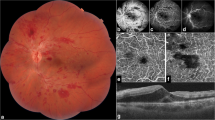Abstract
Purpose
Frosted branch angiitis (FBA) is a rare entity characterized by acute panuveitis in the form of a florid translucent retinal perivascular sheathing of both arterioles and venules, with variable uveitis, retinal edema and visual loss. Primary and secondary cases have been described in association with infectious, inflammatory and malignant etiologies. We aim to describe the clinical course and long-term visual outcome of three patients who developed retinal vein occlusion (RVO) and macular edema as a complication of FBA.
Methods
Descriptive case series.
Results
Three young healthy patients aged 22, 37 and 45 years presented with sudden visual disturbance secondary to unilateral primary FBA, which improved significantly following high-dose steroid therapy. Several weeks later, RVO developed, with marked cystoid macular edema. Visual improvement was achieved and maintained with anti-VEGF therapy over a follow-up period ranging from 14 to 44 months.
Conclusion
FBA may be considered a risk factor for the development of secondary RVO because of the severe retinal vasculitis that eventually leads to activation of the coagulation system and retinal thrombosis. It remains to be determined whether antiplatelet therapy needs to be administered prophylactically in such a scenario in order to reduce the risk or prevent the development of RVO.




Similar content being viewed by others
References
Walker S, Iguchi A, Jones NP (2004) Frosted branch angiitis: a review. Eye (Lond) 18:527–533
Kaburaki T, Nakamura M, Nagasawa K et al (2001) Two cases of frosted branch angiitis with central retinal vein occlusion. Jpn J Ophthalmol 45:628–633
Abu El-Asrar AM, Al-Obeidan SA, Abdel Gader AG (2003) Retinal periphlebitis resembling frosted branch angiitis with nonperfused central retinal vein occlusion. Eur J Ophthalmol 13:807–812
Satoh S, Itoh C, Nakamura N (2010) A case of frosted branch angiitis associated with retinal vein occlusion as a complication of familial Mediterranean fever. Nihon Ganka Gakkai Zasshi 114:621–628
Jackson TE, Pathak S, Doran RM (2011) Behçet disease presenting with frosted branch angiitis. Ocul Immunol Inflamm 19:65–66
Brown DM, Campochiaro PA, Singh RP et al (2010) CRUISE Investigators. Ranibizumab for macular edema following central retinal vein occlusion: six-month primary end point results of a phase III study. Ophthalmology 117:1124–1133
Emmi G, Silvestri E, Squatrito D et al (2015) Thrombosis in vasculitis: from pathogenesis to treatment. Thromb J 13:15
Maugeri N, Baldini M, Ramirez GA et al (2012) Platelet-leukocyte deregulated interactions foster sterile inflammation and tissue damage in immune-mediated vessel diseases. Thromb Res 129:267–273
Pefkianaki M, Androudi S, Praidou A et al (2011) Ocular disease awareness and pattern of ocular manifestation in patients with biopsy-proven lung sarcoidosis. J Ophthal Inflamm Infect 1:141–145
Fountain JA, Werner RB (1984) Tuberculous retinal vasculitis. Retina 4:48–50
Hayreh SS, Podhajsky PA, Zimmerman MB (2011) Central and hemicentral retinal vein occlusion: role of anti-platelet aggregation agents and anticoagulants. Ophthalmology 118:1603–1611
Author information
Authors and Affiliations
Corresponding author
Ethics declarations
All procedures performed in studies involving human participants were in accordance with the ethical standards of the institutional and/or national research committee and with the 1964 Declaration of Helsinki declaration and its later amendments or comparable ethical standards.
For this type of retrospective study, formal consent is not required.
Funding
No funding was received for this research
Conflict of interest
All authors certify that they have no affiliations with or involvement in any organization or entity with any financial interest (such as honoraria; educational grants; participation in speakers’ bureaus; membership, employment, consultancies, stock ownership, or other equity interest; or expert testimony or patent-licensing arrangements) or non-financial interest (such as personal or professional relationships, affiliations, knowledge or beliefs) in the subject matter or materials discussed in this manuscript.
Rights and permissions
About this article
Cite this article
Greifner, G., Neri, P. & Amer, R. Frosted branch angiitis complicated by retinal vein occlusion: clinical course and long-term visual outcome. Graefes Arch Clin Exp Ophthalmol 254, 541–544 (2016). https://doi.org/10.1007/s00417-015-3255-0
Received:
Revised:
Accepted:
Published:
Issue Date:
DOI: https://doi.org/10.1007/s00417-015-3255-0




